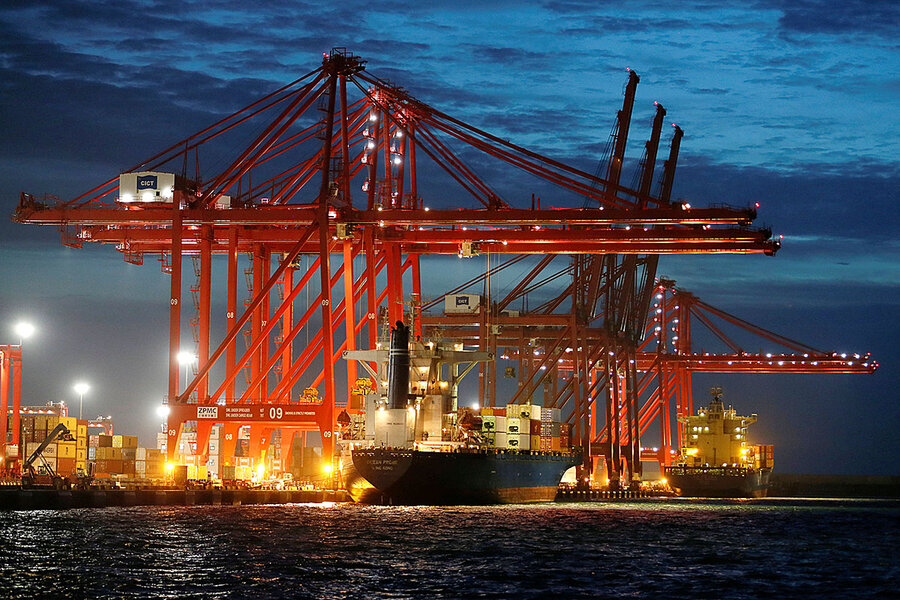Trade war drumbeat masks a deeper challenge from China
Loading...
| London
Tensions between the United States and China may bring to mind the dueling cold war campaigns by the Soviet Union and the US for influence in Asia, Africa, and Latin America in the 1970s. China has undertaken an ambitious program to parlay its economic clout into strategic influence across the globe. But the historical differences outweigh the parallels. China has a modern economy. And its initiative is far more economically robust. Its trillion-dollar centerpiece, called Belt and Road, funds infrastructure projects in dozens of countries. Typically, those are built by Chinese companies and funded in part by billions of dollars in loans. Some Belt and Road partners may not be able to repay, however, giving Beijing leverage to secure wider gains. That happened in Sri Lanka, where China took control of a port, and worries are growing that Djibouti, home of a US military base, may be in a similar position. How should the US respond? Its recent announcement of $113 million to fund development partnerships across Asia is relatively microscopic. The US is also hampered by strained relations with allies on whom they relied for leverage.
Why We Wrote This
China’s drive for global influence might seem to mirror that of the USSR during the cold war. But its effort is built on a different sense of power. A biweekly column on patterns in diplomacy.
Trade War with China! The very phrase conveys the potential gravity of Washington’s campaign to rebalance the relationship between the world’s two largest economies, and address what the United States and many other countries view as unfair commercial practices by the Chinese.
But as sometimes happens, the drumbeat of daily headlines can mask a deeper story: in this case, that trade may not be the main test posed by Chinese policies. A more serious, long-term challenge could lie in the ambitious program being undertaken under President Xi Jinping to parlay China’s economic clout into expanded financial, political, and strategic influence across the globe.
If that sounds familiar, that’s perhaps because of echoes from the dueling cold war campaigns by the Soviet Union and the US for influence in post-colonial Asia, Africa, and Latin America through the late 1970s.
Why We Wrote This
China’s drive for global influence might seem to mirror that of the USSR during the cold war. But its effort is built on a different sense of power. A biweekly column on patterns in diplomacy.
But the historical differences outweigh the parallels. The Chinese initiative is far larger and more economically robust than the Soviets’ mix of aid and arms sales to the developing world. And the USSR was, in some respects, not that much more developed economically than the states it sought to partner and influence.
A muscular drive for new relationships
China, like the old USSR, does have a political system rooted in control by the Communist Party, and increasingly in President Xi himself. But it has a modern economy, with powerful trade and financial links to the rest of the developed world, giving muscle to its drive for new relationships across Asia and Africa. That effort is part of an overall geopolitical strategy, portrayed by Xi as ending China’s relative lack of assertiveness since Mao Zedong’s Cultural Revolution and reconnecting the country with its historic identity as a world power.
Its trillion-dollar centerpiece is called Belt and Road. It aims to revive the old Silk Road trading routes between China and the West through infrastructure projects in dozens of countries, beginning with its near neighbors in central Asia and fanning out across southern Asia and into Africa. The official narrative is that this is a “win-win” for all involved. When the Chinese have come calling – with plans for roads and railways, pipelines and ports, in countries that undeniably need new infrastructure – recipient states have almost invariably said “yes.”
But there’s a rub, increasingly concerning to the US and allied countries. Typically, the projects are built by Chinese companies. They’re funded by a mix of concessionary exports of raw materials back to China and by billions of dollars in loans. A number of China’s Belt and Road partners are already deep in debt, however. They run the risk of not being able to repay, giving Beijing leverage to secure wider geopolitical gains.
This isn’t just theoretical. In Sri Lanka, China built a port on the island nation’s southern coast. Late last year, after protracted negotiations over the Sri Lankans’ inability to repay, Chinese state companies were given control of the facility, a few hundred miles off the coast of India.
Djibouti, on the Horn of Africa, is a small state with outsized strategic significance. It sits on the Bab el Mandeb strait, across from Yemen at the foot of the Red Sea, and is home to the only permanent US military base in Africa.
There, too, China has built a port, as well as a railway and other projects. But shortly after opening the port last year, it also inaugurated its first overseas naval base a few miles away. Given the likelihood Djibouti will find it hard to repay its infrastructure loans, there is now concern the government may end up ceding a wider military footprint to the Chinese.
The question for US policymakers has been how to respond. In recent days, the Trump administration has unveiled what seems the beginning of an answer. As the Monitor reported, Secretary of State Mike Pompeo announced a plan to fund infrastructure and development partnerships across Asia, ahead of his own visit to the region, which just concluded.
Still, the initial sum – $113 million – was microscopic compared with Belt and Road. Mr. Pompeo seems aware that a key component in a broader, sustained reply will be coordination with, and support from, allied countries. In fact, that may turn out to be the case in resolving the trade dispute with the Chinese.
So far, the administration has been betting that the imposition of increasingly wide tariffs will bring Beijing to the negotiating table. That could yet happen. An all-out trade war would cause further pain not just to US businesses but China’s economy. Still, amid new tit-for-tat tariff threats, White House economic aide Larry Kudlow has also spoken of efforts to enlist the European Union in a “united front” against Chinese commercial malpractices.
The challenge for Washington is its allies' increasing discomfort with America First policies. The EU remains subject to new US steel and aluminum tariffs imposed earlier this year. In Asia, one of President Trump’s first acts was to withdraw from the Trans-Pacific Partnership, a trade agreement negotiated with allies during the Obama administration as a counterbalance to potential Chinese economic dominance in the region.
The issue of how the US deals with allies in responding to Chinese trade and overseas infrastructure policies has now brought a more fundamental question about the administration’s future course into focus. In a surprise visit last January to the annual World Economic Forum in Davos, the president declared: “America First does not mean America alone.” His next words made clear what he meant: that by directing all his policy energies to American economic growth, the rest of the world would benefit, too. But with China, he may be faced with deciding whether America’s own interests can be secured without calling on the kind of alliances previous administrations have long relied upon.








